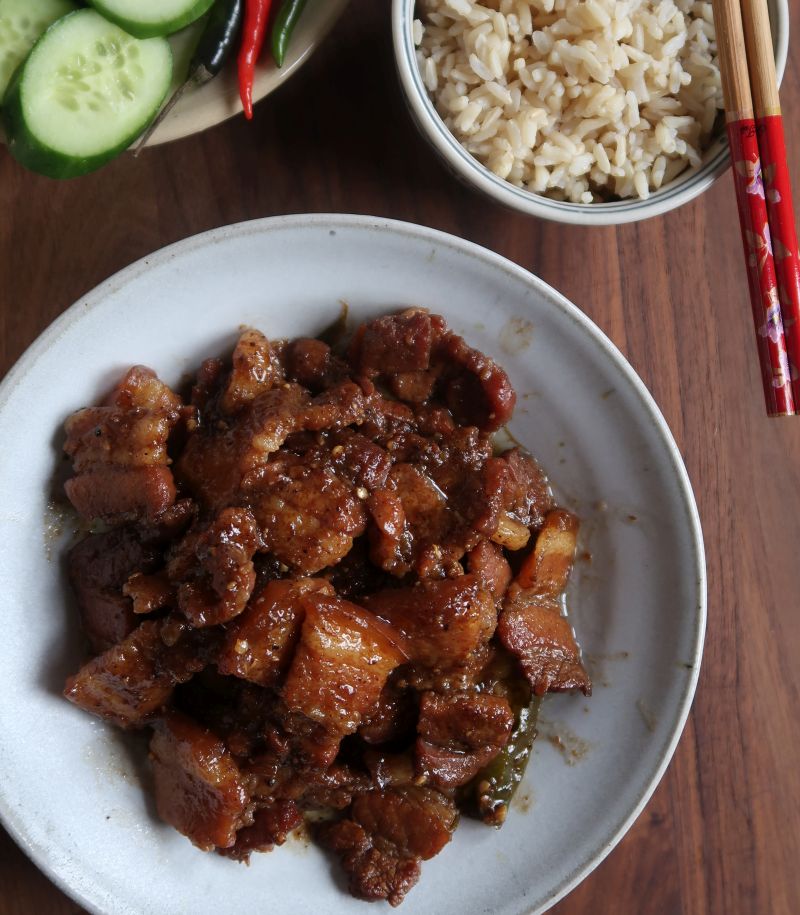
What does a family cook when they have access to all the artisanal fish sauce products that they could possibly ever need? The Pham family that owns Red Boat Fish Sauce often cooks up a fast, homey Viet favorite – pork belly in caramel sauce. Ann Pham has a recipe that her husband Cuong Pham (Red Boat's founder) and her children have been enjoying for over twenty years. They simply call it thit kho (“theet kaw”) but you may have seen it as thit ba chi kho or thit ba chi kho man ngot on restaurant menus; ba chi refers to pork belly and man ngot means savory sweet.
There are countless versions of the savory-sweet favorite, which cleverly uses basic ingredients to turn a small amount of meat into a big flavor bomb. Vietnamese pork belly in caramel sauce is perfect to eat with lots of rice (to spread the wealth of flavor) and a simple vegetable (to cut the pork’s richness). I’ve known Ann for years and we’ve dined together. She has a good palate. That’s why I asked for the recipe to try out.
What is kho?
In the Vietnamese repertoire, foods that are braised, simmered or stewed belong to a broad category of dishes called kho. They may be East-West stews like bo kho, a tomatoey beef, star anise and lemongrass stew with carrots that’s often eaten with baguette. Most cooks prepare kho by simmering proteins with fish sauce, shallot or onion, and salt and pepper plus caramel sauce. The caramel sauce is not what you’d put on ice cream. It’s super caramelized, nearly burnt sugar, a nifty trick that allows Viet cooks to build umami.
Ann applies her Viet roots to thit kho by using palm sugar for the caramel. She also adds Red Boat Salt and fish sauce to lay a deep savory foundation, a signature note that reflects their family's artisanal products.
Cuong asked me to help spread the word about their salt and I'd written a primer on their uncommon seasoning and used it for a super umami steak recipe. But I wanted a signature recipe that belonged to the Phams. Ann's earthy pork belly in caramel sauce comes together in about 20 minutes. Its simple deliciousness embodies Vietnamese soul food.
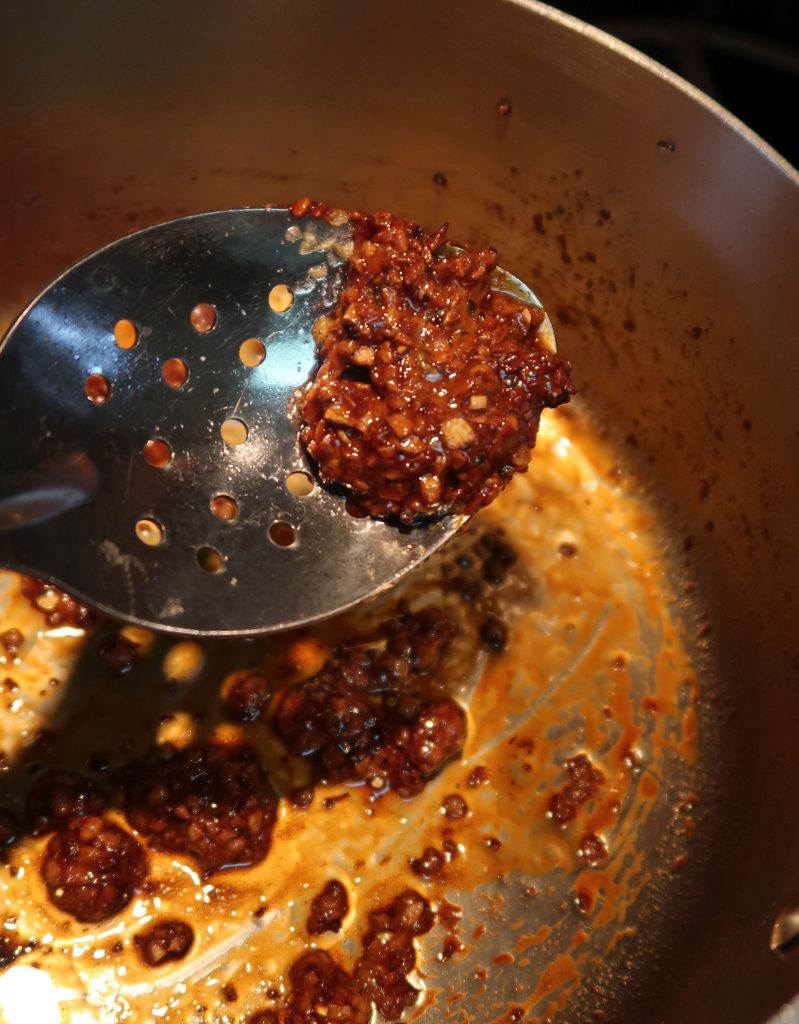
(In the recipe, you'll be pushing the sugar to cook until it's richly brown. Note that I say to use a silicone spatula. After I took the photo above, the sugar was stuck on the metal spoon and I had to simmer the pork with the spoon in the pot until the sugar loosened off. You can easily knock it off silicone.)
Palm Sugar vs. Granulated Sugar
To replicate this Pham family ("Phamily"!) favorite, you don’t need palm sugar. You can use regular white granulated sugar — it’s readily available. Cane sugar, such as C&H, caramelizes beautifully and consistently; beet sugar can be problematic. Palm sugar varies so much in flavor and quality that when my mom came to America, she was happy to buy refined white sugar at the supermarket for her kho dishes!
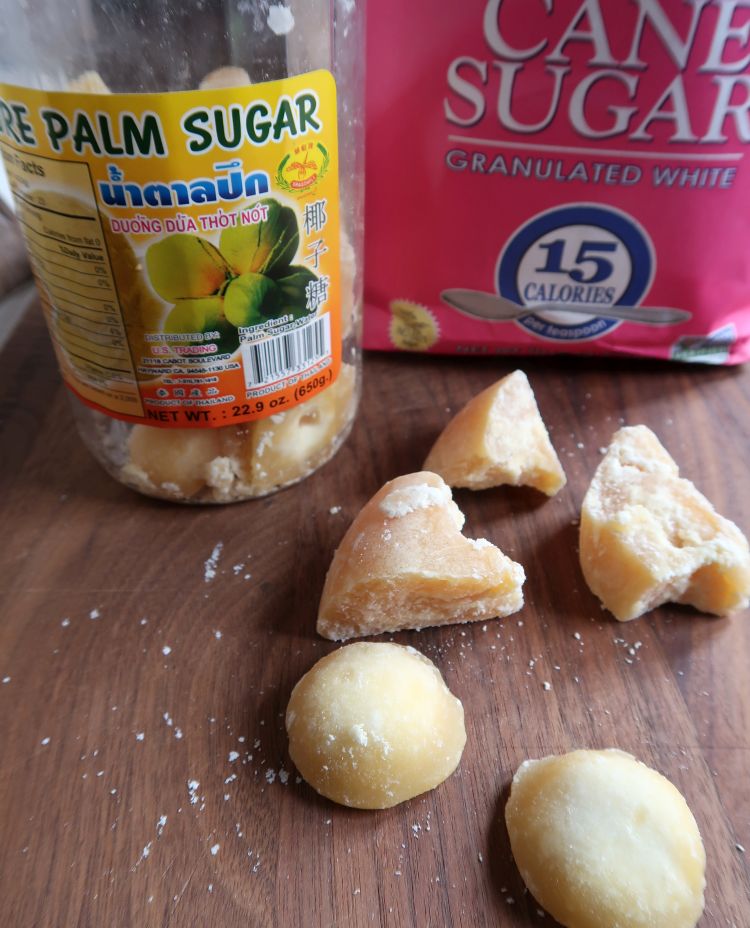
I tested the Phamily pork belly recipe three times and what tripped me up was the sugar. Palm sugar can be very dense and heavy. For example, that single round mound in the photo weighs a little shy of 1 ounce and it occupies 1 tablespoon. In granulated sugar terms, 2 tablespoons weigh about ¾ ounce. That’s why you see the ingredient line for sugar below.
Also, when using palm sugar, you need to grate or chop it up to make it easier to handle. Soften it in the microwave on 15-second blasts for faster prep. Palm sugar is an unrefined sugar and comes in light and dark colors; Viet people use the lighter/more yellow one whereas Malaysians and Indonesians prefer darker palm sugar. Refined sugar, like the jaggery used for the Indian tamarind date loaf, abound in tropical Asia.
Pork Belly Buying Tips and Subs
If you shop at Asian markets, you’ll see lean and fatty pork belly. The Phamfily use lean pork belly for this dish. When I shopped for the meat at Whole Foods (the price is practically the same as at an Asian market), most of the pork belly was extremely fatty. I told the butcher that I would be making an Asian braise type of dish and he selected the leaner end of the pork belly for my cut. It pays to make friends with butchers.
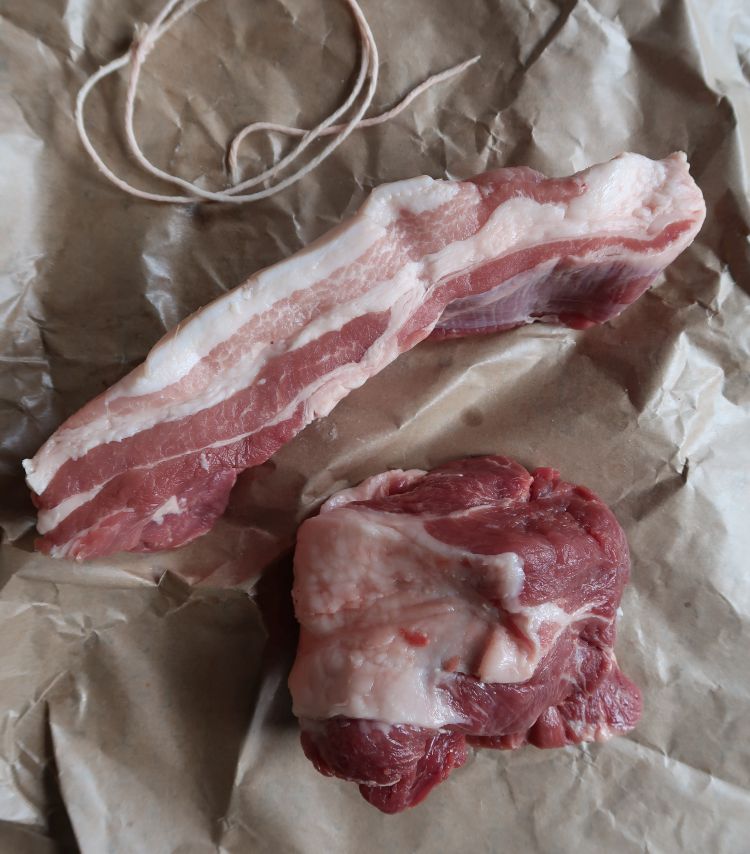
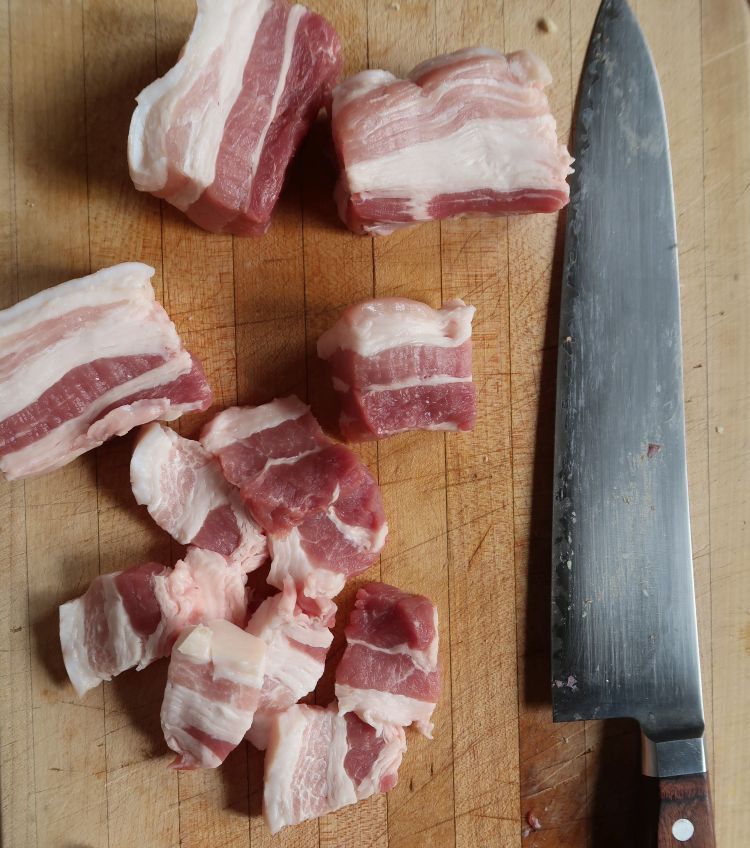
What if there’s no pork belly nearby? Use fatty pork shoulder (the piece on the bottom). It will not as much textural variation since it has no skin but it will be very tasty; the advantage with shoulder is you'll have less fat to remove at the end. The only trick is to cut the shoulder in to smallish piece. I freeze the pork in chunks for about 15 minutes before slicing. You could even combine pork belly and shoulder.
Red Boat Salt and Fish Sauce
The Phamily pork belly in caramel sauce recipe uses their salt and fish sauce. The salt is their secret weapon for an extra hit of umami oomph. You can substitute regular salt (see the recipe introduction for a suggestion) and another brand of fish sauce. But if you have Red Boat Salt and fish sauce on hand, used it and you’ll get an insider’s taste of what the Phamily cooks up!
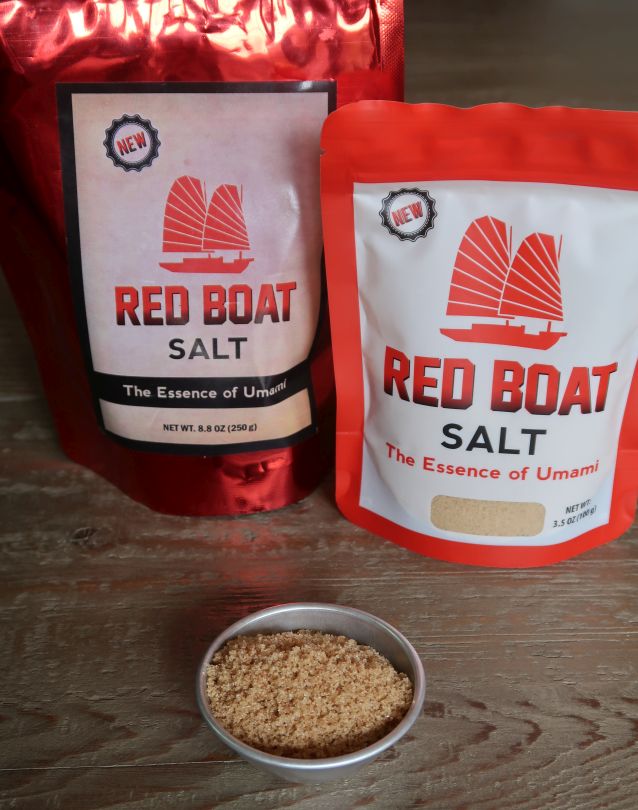
Note that this recipe uses the RB salt straight up. There’s no blending like I did for the super umami steak recipe.
Ann's daughter, Tiffany, enjoys lots of crunchy cucumber and rice with this pork belly. You may add a boiled green vegetable like broccoli, if you like.
Red Boat Pork Belly in Caramel Sauce
Ingredients
- 1 pound lean pork belly, with or without skin, or fatty pork shoulder
- 1 ½ teaspoons Red Boat Salt
- ¾ teaspoon recently or freshly ground black pepper
- 2 teaspoons neutral oil, such as canola
- 1 small shallot, minced (1 ½ tablespoons)
- 1 large garlic clove, minced (1 ½ teaspoons)
- 2 tablespoons white granulated sugar or shaved light palm sugar (about 1 ounce)
- 1 tablespoon Red Boat fish sauce
- 2 tablespoons water
- 1 or 2 Thai chilis, split lengthwise
- 1 Persian cucumber, thickly sliced on the diagonal
Instructions
- If using pork belly, cut across the meat grain into 1 to 1 ¼-inch wide rectangular chunks. Then cut the chunks into ¼-inch-thick pieces. (When using pork shoulder, do your best to cut it into similar size pieces, each about ¼-inch thick. Try to get a little fat with the lean.) Season the pork with the salt and pepper and set aside.
- In a 3-quart saucepan, warm the oil over medium heat. Add the shallot and garlic, and cook, stirring frequently for about 2 minutes, until some pieces start browning. Turn off the heat.
- Slide the pan to a cold burner, let the cooking calm down, then transfer the shallot and garlic to a small bowl of plate. Keep nearby.
- Replace the pan over medium heat, add the sugar then let the sugar melt, stirring frequently with a silicone spatula. Once sugar has melted and caramelized to a light orange, about 1 minute, add back the shallot and garlic. Cook for about 2 minutes longer, to further brown the aromatics and push the caramelization to a rich dark brown. Lower the heat if the pan seems to get out of control, or if there’s smoke.
- Dump in the pork and mix well. Stir frequently to cook the pork until it no longer looks raw, about 2 minutes. Sugar will stick to your spatula so knock it off with a spoon or other utensil.
- Add the fish sauce, water, and Thai chilis. Stir and let come to a vigorous simmer. Cover and lower the heat to gently simmer. Let cook for 10 to 15 minutes, stirring occasionally and lowering the heat as needed. The pork is done when it is firm tender, a lovely brown-red color, and there’s a rich sauce in the pan. Turn off the heat, cover, and let rest 5 minutes for flavors to meld.
- If there’s too much fat (a possibility with the pork belly), use a slotted spoon to transfer the pork to a bowl. Tilt the pan and use a metal ladle to remove as much fat as you like; save the fat for other uses. Replace the pork in the pan and stir to coat in sauce.
- Taste the pork and sauce. If needed, add a sprinkling of Red Boat Salt, fish sauce, pepper, or sugar to create a savory, spicy sweet finish. If the flavor is too salty or you just want more sauce, stir in water by the tablespoon and if needed, reheat to combine. Transfer to a shallow bowl and serve with the cucumbers on a separate dish as an accompaniment.













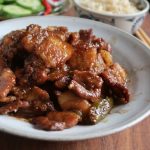




Simi & Stefan says
Hi Andrea, I'm Stefan from asiastreetfood. I enjoyed your article very much and can tell you the story we had with the Phamily in October last year at Phu Quoc: My wife Simi and I organized the Red Boat Chef Trip to Vietnam on the German side.
At Phu Quoc Ann yearned for her beloved Thit Kho. So I prepared it at the Chefs Dinner - a wonderful event at the beach.
I used RB Salt, RB Fish sauce and very crucial RB Palm Sugar from Cambodia. Ask Cuong to give you a try. It's absolutely great and improves the taste dramatically. Ann loved it and was surprised that you can make Thit Kho also without using coconut water 🙂
By the way, congrats for getting your Pho Book to Germany!
Hope to meet you one day
Andrea Nguyen says
Thank you for taking time to write a note! So great that you were able to visit Phu Quoc and the Red Boat facilities. The Phams are a kind and generous family.
There are different styles of thit kho, with and without coconut water. There are also many kinds of kho, as you know.
I was really happy to see "The Pho Cookbook" translated into German; the new name is quite clever! It's signals great things for global cooking and eating.
Take care and all the best!
Krista says
I've been craving the noodle bowls from my local Vietnamese restaurant and the pork was a wonderful topping. They only had thick-sliced pieces of pork side at my grocery store so I made this with that and it turned out phenomenally! This will probably be a weekly go-to, thank you so much for sharing.
Andrea Nguyen says
You're so welcome! I didn't think of this on a noodle bowl but it would totally work! Awesome tip.
Claire Pallister says
This tastes delicious thank you